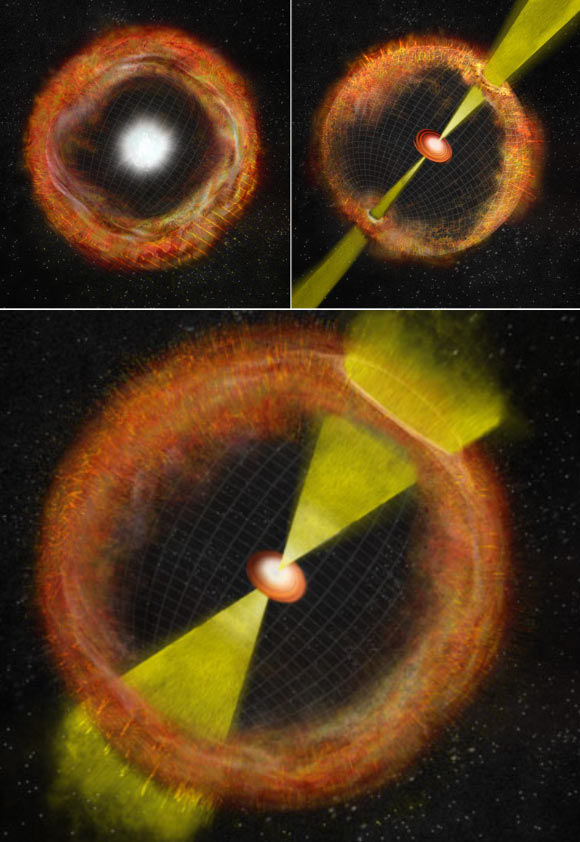
Astronomers say they’ve found a long-sought missing link between supernova explosions that generate gamma-ray bursts (GRBs) and those that don’t. It’s a supernova seen in 2012 – now called Supernova 2012ap by astronomers – and it has many characteristics expected of one that generates a powerful burst of gamma rays. Yet no such burst occurred. Sayan Chakraborti, of the Harvard-Smithsonian Center for Astrophysics (CfA) said this week (April 27, 2015) in a statement from the National Radio Astronomy Observatory:
This is a striking result that provides a key insight about the mechanism underlying these explosions. This object fills in a gap between GRBs and other supernovae of this type, showing us that a wide range of activity is possible in such blasts.
Supernova 2012ap (SN 2012ap) – located in a galaxy called NGC 1729 – is what astronomers term a core-collapse supernova. This type of blast occurs when the nuclear fusion reactions at the core of a very massive star no longer can provide the energy needed to hold up the core against the weight of the outer parts of the star. The core then collapses catastrophically into a superdense neutron star or a black hole. The rest of the star’s material is blasted into space in a supernova explosion.
The most common type of such a supernova blasts the star’s material outward in a nearly-spherical bubble that expands rapidly, but at speeds far less than that of light. These explosions produce no burst of gamma rays.
In a small percentage of cases, the infalling material is drawn into a short-lived swirling disk surrounding the new neutron star or black hole. This accretion disk generates jets of material that move outward from the disk’s poles at speeds approaching that of light. It turns out it may be the speed of the material in the jets that makes a difference between gamma-ray bursts, or no gamma-ray bursts.

The combination of a recent supernova’s swirling disk – and its powerful jets – is called an engine by astronomers. Engine-driven supernovae are known to produce gamma-ray bursts.
However, according to the new research, that not all engine-drive supernovae produce gamma-ray bursts. For example, Supernova 2012ap did not. Alicia Soderberg, also of CfA, said:
This supernova had jets moving at nearly the speed of light, and those jets were quickly slowed down, just like the jets we see in gamma-ray bursts.
An earlier supernova seen in 2009 also had fast jets, but its jets expanded freely, without experiencing the slowdown characteristic of those that generate gamma-ray bursts. The free expansion of the 2009 object, the scientists said, is more like what is seen in supernova explosions with no engine, and probably indicates that its jet contained a large percentage of heavy particles, as opposed to the lighter particles in gamma-ray-burst jets. The heavy particles more easily make their way through the material surrounding the star. Chakraborti said:
What we see is that there is a wide diversity in the engines in this type of supernova explosion. Those with strong engines and lighter particles produce gamma-ray bursts, and those with weaker engines and heavier particles don’t.
This object shows that the nature of the engine plays a central role in determining the characteristics of this type of supernova explosion.
Bottom line: A supernova seen in 2012 – called Supernova 2012ap, located in a galaxy called NGC 1729 – had many characteristics expected of a supernova that generates a powerful burst of gamma rays. Yet no such burst occurred. Astronomers have used this event to refine their ideas about why some supernova explosions produce gamma-ray bursts and others don’t.











